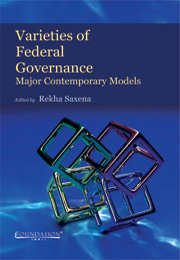Book contents
- Frontmatter
- Contents
- List of Contributors
- Foreword
- Acknowledgements
- Introduction
- I Theoretical and Comparative Dimensions
- II Presidential Federal Systems
- III Commonwealth Parliamentary Federations
- 8 Constitutional Normalization in Canada: The Significance of Failure of the Charlottetown Agreement
- 9 The Australian Senate: Form, Function and Effectiveness
- 10 Federalizing India's Political Parties: National All-India and National Interstate Parties
- 11 Malaysia: Centralized Federalism in an Electoral One-Party State
- 12 Promises Unmet: Multi-level Government in South Africa
- IV Non-Commonwealth Parliamentary Federations in Afro-Asia
- V European Parliamentary Federations
- VI Devolutionary Systems
- VII Supranational Confederalism/Federalism?
8 - Constitutional Normalization in Canada: The Significance of Failure of the Charlottetown Agreement
from III - Commonwealth Parliamentary Federations
Published online by Cambridge University Press: 05 June 2012
- Frontmatter
- Contents
- List of Contributors
- Foreword
- Acknowledgements
- Introduction
- I Theoretical and Comparative Dimensions
- II Presidential Federal Systems
- III Commonwealth Parliamentary Federations
- 8 Constitutional Normalization in Canada: The Significance of Failure of the Charlottetown Agreement
- 9 The Australian Senate: Form, Function and Effectiveness
- 10 Federalizing India's Political Parties: National All-India and National Interstate Parties
- 11 Malaysia: Centralized Federalism in an Electoral One-Party State
- 12 Promises Unmet: Multi-level Government in South Africa
- IV Non-Commonwealth Parliamentary Federations in Afro-Asia
- V European Parliamentary Federations
- VI Devolutionary Systems
- VII Supranational Confederalism/Federalism?
Summary
The Canadian federal structure devised in 1867 proved remarkably effective and adaptable during its first century in adjusting incrementally to the many changing conditions within Canadian society and in the external world. Between the 1960s and the 1990s, however, it clearly came under increasing stress. Indeed, Donald Smiley, a leading scholar of Canadian federalism, writing a book about the problems facing Canada in the 1970s, was driven to choose the title Canada in Question. In 1992, after 54 per cent of its people and six of its ten provinces had said ‘No’ in the referendum of October 26 to the set of constitutional proposals constituting the Charlottetown Agreement on which they were asked to vote, fundamental constitutional issues were left unresolved, and the future of Canada seemed again to be in question.
The Unresolved Structural Problems of Canada
By most standards, Canada during the 125 years since Confederation, had been up to 1992, a country of extraordinary accomplishment, admired and envied throughout the world. That year a United Nations report ranked Canada as the best country in the world to live in. But the question is if Canada had been a land of such achievement, why did it appear to be in such constitutional disarray? The answer to that question lay in four sets of structural problems that Canadians had difficulty to resolve.
- Type
- Chapter
- Information
- Varieties of Federal GovernanceMajor Contemporary Models, pp. 131 - 141Publisher: Foundation BooksPrint publication year: 2011



